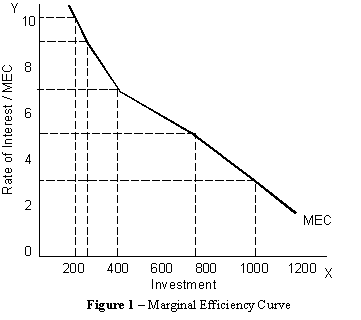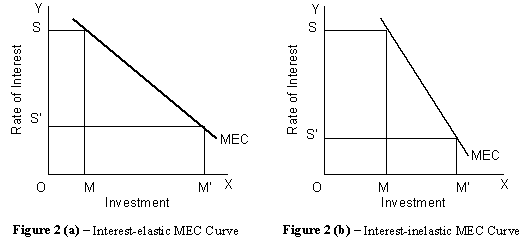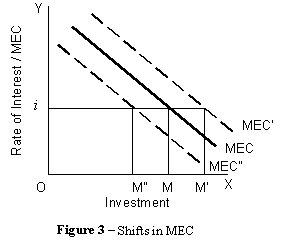
Investment, in the
theory of income and employment, means, an addition to the nation’s stock of
capital like the building of new factories, new machines as well as any addition
to the stock of finished goods or the goods in the pipelines of production.
Investment includes addition to inventories as well as to fixed capital.
Thus, investment does not mean purchase of existing securities or titles,
i.e., bonds, debentures, shares, etc. Such
transactions do not add to the existing capital but merely mean change in
ownership of the assets already in existence.
They do not create income and employment. Real investment means the purchase of new factories, plants
and machineries, because only newly constructed or created assets create
employment or generate income.
Types
of Investment:
Induced
investment varies with NI. Changes
in NI bring about changes in aggregate demand which in turn affects the volume
of investment. When NI increases,
AD too increases, and investment has to be undertaken to meet this increased
demand. Thus induced investment is
income-elastic.
Investment
is made by the people as a result of changes in income level or consumption.
It is also influenced by price changes, interest changes, etc., which
affect profit possibilities. It is
undertaken for the sake of profit or income and it changes with a change in
income. Thus, induced investment is
governed by profit motive.
Factors
Affecting Investment:
Marginal
Efficiency of Capital (MEC):
MEC is the highest rate of return expected from an additional unit of a capital asset over its cost. It is the expected rate of profitability of a new capital asset. J.M. Keynes has defined MEC as being equal to the rate of discount which would make the present value of the series of annuities given by the returns expected from the capital assets during its life just equal to the supply price. Symbolically it is expressed as:

Where Sp
denotes supply price or replace cost of the asset, R1, R2,…..Rn
are the prospective annual returns or yield from the capital asset in the year
1, 2, and n respectively. i is the rate of discount which makes the
capital asset exactly equal to the present value of the expected yield from it.
Investment-Demand
Curve:
The investment-demand
schedule is also known as MEC schedule. The
MEC schedule shows a functional relationship between MEC and the amount of
investment in a given type of capital asset at a particular period of time for
the whole economy.
|
Investment (In
Million US $) |
MEC / Rate of Interest (In %) |
|
200 |
10 |
|
250 |
9 |
|
400 |
7 |
|
750 |
5 |
|
1000 |
3 |

In the above diagram,
the marginal efficiency of capital is represented by MEC curve. It slopes downward from left to right which means that as
investment increased its marginal efficiency goes down.
Investment at any
time depends on the rate of interest prevailing at that time.
If the rate of interest is 5%, the investment is US $750 million,
because, at this level, MEC is equal to the rate of interest.
The MEC represents the investor’s return and the rate of interest is
his cost. Obviously, the return on
capital must at least be equal to the rate of interest, which is its cost.
Suppose the rate of interest goes down to 3%, then it will become
worthwhile to invest US $1,000 million. Thus,
the MEC and the rate of interest move together.
Position and Shape of MEC Curve: The elasticity of MEC determines the extent to which the volume of investment would change consequent upon changes in the rate of interest. If MEC is relatively interest-elastic, a little fall in the rate of interest will result in a considerable expansion in the volume of investment. On the other hand, if the MEC is relatively interest-inelastic, then a considerable fall in the rate of interest may not lead to any increase in the volume of investment.

Shifts in MEC: As the expectations regarding the prospective yields change, the MEC will change too and the MEC curve will shift upwards or downwards. It is illustrated in the following diagram:

Suppose a war breaks
out or demand for goods increases on account of some other reason. As a result, entrepreneurs’ expectations of profit will
rise high and the investment demand curve or the MEC curve will shift upwards to
MEC’. This means that at a given
rate of interest, investment will be greater than before. From the above diagram, it will be seen that whereas the rate
of interest i, investment was OM before, it now becomes OM’.
Similarly, if for some reason demand for goods has decreased bringing
down the MEC to MEC” at the same rate of interest i, investment will
only be OM” as compared with OM before.
Influence of Rate of Interest: The rate of interest along with the MEC determines the volume of investment. If the rate of interest is higher than the MEC, it will not be profitable to create a new physical asset. This is because we assume that the aim of individual investor is to maximise the money profits. Two courses of action are open to invest, either he can use his money to crease additional physical assets, i.e., he can invest in the Keynesian sense of the term, or else he can lend his money to others at a certain rate of interest. Now, if MEC is lower than the current rate of interest, it is more profitable to lend money rather than use it for creating new assets. On the other hand, if MEC is higher than the rate of interest, it is better to invest more. At the point, where MEC equals the current rate of interest, we have the equilibrium level of investment.
Factors
of MEC:
The marginal
efficiency of capital depends upon psychological and objective factors:
(a)
MEC
and the Market: If
the market of a particular commodity is wide and is expected to grow further,
the investment in that project will be favourable and the MEC high. On the other hand, if the demand of a particular commodity is
limited and is expected to decline in the future, the investment will be
discouraged in that project and the MEC will be low.
(b)
Rate
of Growth of Population: MEC is also
influenced by the rate of growth of population. If population is growing at a rapid speed, it is usually
believed that the demand of various classes of goods will increase.
So a rapid rise in the growth of population will increase the MEC and a
slowing down in its rate of growth will discourage investment and thus reduce
MEC.
(c)
Technological
Development: If inventions and
technological development take place in the industry, the prospect of increase
in the net yield brightens up. For
example, the development of automobiles in the 20th century has
greatly stimulated the rubber industry, the steel and oil industry, etc.
So we can say that inventions and technological developments encourage
investment in various projects and increase MEC.
(d)
Existed
Capital Goods: If
the quantity of any particular type of goods is available in abundance in the
market and the consumers can partially or fully meet demand, then it will not be
advantageous to invest money in that particular project.
So in such cases, the MEC will be low.
(e)
Current
Rate of Investment: Another influence
on the MEC is the rate of investment currently going on in a particular
industry. If in a relevant field,
much investment has already taken place and the rate of investment currently
going on in that industry is also very large, then new investors will hesitate
to invest their money in that direction. As the anticipated net yield from that project will be very
small, so they can invest money in such project only if they expect extremely
favourable demand conditions.
(f) Rate of Taxes: MEC is directly influenced by the rate of taxes levied by the government on various commodities. When taxes are levied, the cost of commodities is increased and the revenue is lowered. When profits are reduced, MEC will naturally be affected. It will be low, if taxes are very high and high if taxes are low.